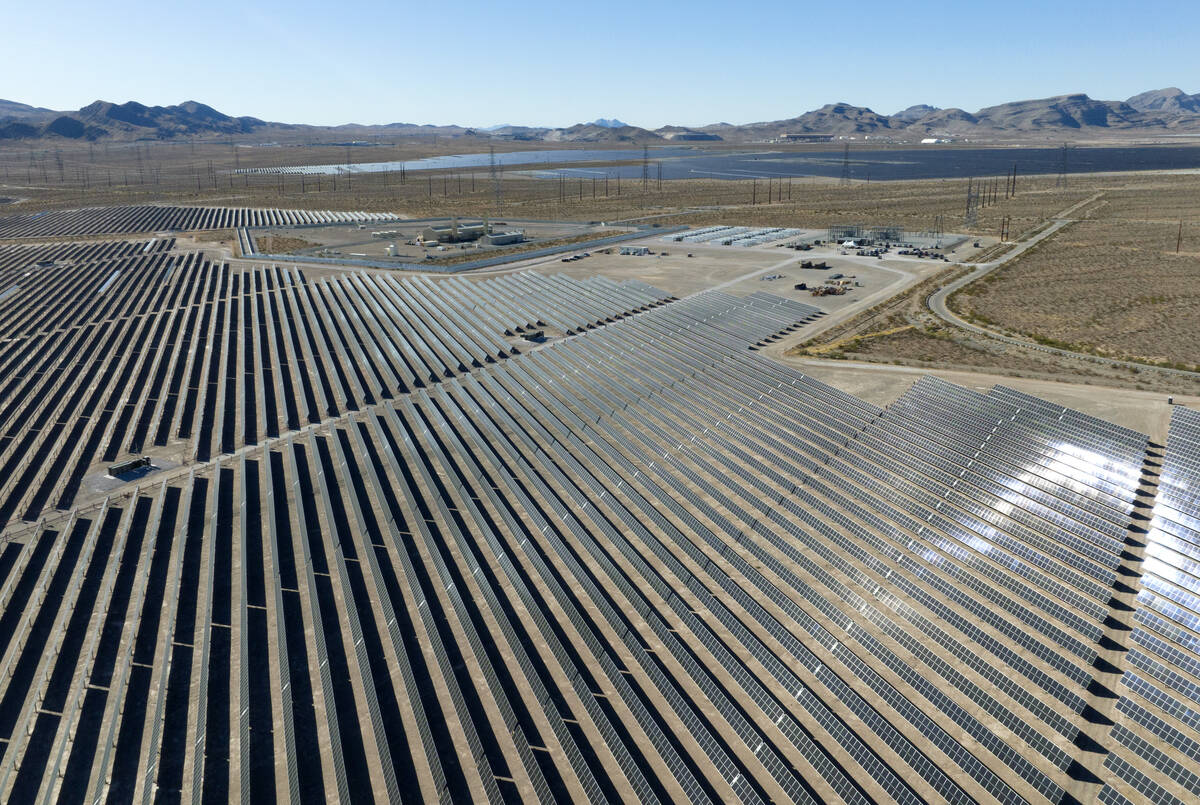Here’s what NV Energy is proposing to build to keep up with energy demand
NV Energy has a plan to keep up with the growing population and energy demand in Nevada, including building three solar and battery storage plants. No price tag for all of the projects was provided.
Here’s what to know about the projects the utility wants to build if approved by the Public Utilities Commission.
What is an Integrated Resource Plan?
NV Energy filed its Integrated Resource Plan to the Public Utilities Commission on May 31 and underwent review from the commission over the past six months. From Nov. 18 to 22, NV Energy went through a “rigorous” hearing process with testimony from stakeholders and customers, the utility said.
An Integrated Resource Plan, or IRP, is an outline of what projects the utility says it needs to build to meet energy demands in growing Southern and Northern Nevada.
“The requested resources present a balanced portfolio that will reduce NV Energy reliance on expensive and unreliable market resources,” said NV Energy CEO Doug Cannon. “[The IRP] will position Nevada to continue to provide reliable energy services at a cost that is below the national average and is more than 50 percent cheaper than energy rates paid by residents of California.”
Solar and Battery Power Plant
In order to meet the requirement of a 50 percent renewable energy portfolio by 2030 imposed by the state Legislature, NV Energy has proposed three solar and battery storage power purchase agreements, or PPA. No estimated cost for the agreements was provided by NV Energy.
A PPA is when an energy generator or developer is given permission to build, maintain and operate on the power company’s land. Then, the company will purchase the power from the developer at a fixed rate.
There are two PPA’s proposed for Southern Nevada and one in Northern Nevada. Dry Lake East located 20 miles northeast of Las Vegas has a proposed capacity of 200 megawatts and is expected to be in service by the end of 2026. The project will also include a 200 megawatt battery with a 4-hour duration and 800 megawatt-hours.
Boulder Solar III will be in Boulder City ‘s El Dorado valley and is proposed to have a 128 MW capacity. The battery will be 128 mega watts with a 4-hour duration and 511.4 megawatt-hours. It is expected to be in service by June 2027.
Libra Solar is located near the Mineral and Lyon County border and is expected to be in service by the end of 2027. The PPA will have a 700 megawatt capacity, with a 700 megawatt battery with a four-hour and 2,800 megawatt-hour duration.
The batteries are for storing extra energy generated by the panels while the sun is down.
Natural Gas ‘Peakers’
The IRP also proposes 400 megawatts of natural gas-powered peaking units co-located at the North Valmy Generating Station east of Winnemucca. The project is projected to finish in 2028 and cost $573 million.
Currently, North Valmy is home to a coal-fueled, steam-electric generating plant, expected to be retired in 2025. With the new plan, North Valmy will be changed from coal to natural gas, effectively ridding Nevada of coal.
The peaking units are power generation plants, running on natural gas, and designed to operate only during periods of high electricity demand in Northern Nevada and do not run constantly.
According to the plan, the plant is a “low cost option” for customers who will be able to use hydrogen in the future and not infringe on clean energy goals.
State environmentalist groups and clean energy groups, including Nevada Conservation League, Advanced Energy United, Western Resource Advocates and Sierra Club, oppose the plan and have urged the PUCN to reject it. They say ratepayers would foot the bill for the peakers and it would lead to a natural gas dependency in the state and have environmental impacts.
“NV Energy must stop playing games with ratepayers and regulators,” said Kristee Watson, executive director of the Nevada Conservation League. “The utility must stop hiding the ball in its planning and put forward the solutions Nevadans are demanding—more clean electricity and more stable and affordable bills.”
Ratepayers foot the bill for the plant in a similar way people pay a mortgage on a home. With a $573 million plant, ratepayers will be paying on the cost of construction until the costs are recovered throughout the plant’s lifetime.
NV Energy pays the costs up front initially after construction, then ratepayers will see an adjustment in their bill, spread out over the lifetime of the plant, which is typically decades.
What’s next?
The PUCN is expected to announce their official order for the IRP on Dec. 20. The orders can get pretty specific on what plans are approved, denied or adjusted.
The IRP currently at the PUCN is not a rate case, but only to approve, deny or adjust the above plans to meet projected customer demand. If approved, NV Energy will go forward with construction — once the plants are constructed and in service, then a case to raise electric rates will be filed.
With the first plant not expected to be in service by the end of 2026, the resulting rate changes shouldn’t be expected until late 2026.
Contact Emerson Drewes at edrewes@reviewjournal.com. Follow @EmersonDrewes on X.























